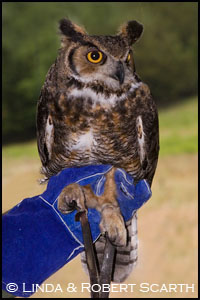introduction - galleries - technique - catalogue - notes - links - contact - blog - deep nature

Great Horned Owl
About twenty five years ago a recently fledged leucistic Blue Jay flew into the side of our car along the country road where we lived. The beautiful white-on-white color pattern and its babyish appearance, plus the fact it was alive were a delight and relief. However, it did back flips when it tried to stand; indicating head trauma. Therefore Linda wrapped it in a towel and took it home.
For the next three weeks it lived in a large cage in a corner of our basement ? warm, quiet and with subdued light, as it gradually recovered its balance. We tried to locate a wildlife rehabilitator, and not finding one did what came naturally to livestock owners ? nursed it back to health. There was no question that we could abandon this ghostly, feisty young bird. It ate Mighty Dog canned dog food, first from a baby spoon and then from a dish. A few drops of water at a time from a dropper helped forestall dehydration until it could stand and drink on its own. Once its balance was secure it rapidly became stronger and practiced wing flaps.
When it was time to release it, Linda took it to the shrubby fence row from which it had flown into the car. It flew back, perched on a visible branch and then, in keeping with its ghostly appearance, faded back into the bushes. That is not the end of the story. About two months later Linda was walking along a creek about a mile from our home when a white Blue Jay landed on a branch in the open and watched her for a few minutes before they went their separate ways.
We do not recommend caring for wild animals, especially since a rehabilitator?s license is required in all states and it is easier to find one now. Licensed wildlife rehabilitators are important, not only for the service they provide to injured animals, but for their roles as educators. The National Wildlife Rehabilitators Association has its office in St. Cloud, MN and offers much useful information on its web site: http://www.nwrawildlife.org. The group has a code of ethics which guides their approach to wild creatures, and is applicable to all who seek to improve the welfare of all native species.
Children have fewer opportunities to wander in woods, along creeks and open fields to learn about life in the wild. Nature educators attempt to fill that lost opportunity, working with school groups, sponsoring programs and being available at nature centers and public functions. Wildlife rehabilitators also take their unreleasable, people-tolerant dependents to schools and other gatherings; often providing the only opportunities for close-up encounters with native North American birds and animals.
As nature photographers we are grateful to capture images of rehabilitators? birds and animals whenever a suitable opportunity arises. Here too, we feel that the same principles to photographing animals in the wild apply, so as not to contribute to the stress they may experience. We also feel strongly that these animals must be identified as unreleaseable educational animals.
This month?s photographs are of birds from several rehabilitation programs. The essay accompanying the Barn Owl is found at http://www.uiowa.edu/~obermann/animals/adults/source/32.html. She (or so we think of her as female) is among the most dignified animals we have ever observed. Her limitations are apparent but her pride and adjustment to her situation bring tears to the eyes of those who meet her. The Turkey Vulture is a very confident self-contained, somewhat humorous, bird who we met for the first time at an art show in a large nature center. He strolled through the booths dragging his jesses (leather leg thongs), discretely followed by his rehabilitator. His kibitzing brought chuckles in his wake. The Red-tailed Hawk and its keeper were sunning themselves on a wall between ?performances? for groups of visitors. And the Great Horned Owl was attending an open house at a nature preserve that is rarely open to the public.
It is possible to photograph captive animals in ways to show their great beauty and resilience, even those that cannot be returned to the wild after some accident, deliberate injury or illness. They sometimes can be kept to help teach about their characters, needs, habitats and place in the world we all share, and should be identified as such. While the animals did not choose this fate, rehabilitators can turn misfortune into another purpose minimizing human ?nature deficit?. Photographers can assist by publishing their images.
? Linda & Robert Scarth, 2007.
First published in NatureScape News, 2 (1), 6, 2007.
